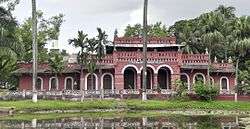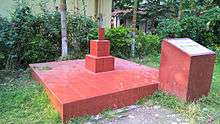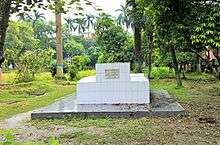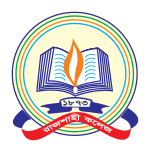Rajshahi College
| রাজশাহী কলেজ | |
|
Rajshahi College Logo | |
Other name | Rajshahi University College |
|---|---|
| Type | Government College |
| Established | 1873 |
| Founder | King Haranath Ray Chowdhury |
Academic affiliation | National University of Bangladesh |
| Chancellor | Abdul Hamid |
| Principal | Md. Habibur Rahman |
| Location |
Rajshahi, Rajshahi, 6100, Bangladesh 24°21′52″N 88°35′45″E / 24.3645°N 88.5958°ECoordinates: 24°21′52″N 88°35′45″E / 24.3645°N 88.5958°E |
| Campus | Rural |
| Colors | |
| Website |
rc |

Rajshahi College (Bengali: রাজশাহী কলেজ Rajshahi Kôlej) is the third oldest institutions of higher education in Bangladesh. Established in 1873 in Rajshahi city, it is the third oldest college in Bangladesh after Dhaka College and Chittagong College. In 1895 Rajshahi College was the first institution in the territories now comprising Bangladesh to award a graduate(Master's) degree. The first two master's degree candidates, Mr. Cayan Uddin Ahmet(Chawyone Uddin Ahmed) and Mr. N. N. Lehari, who after graduation became Chief Secretary of Bengal and Session Judge respectively. Later both were awarded Khan Bahadur and Roy Bahadur titles. Rajshahi College offers three years bachelor and four years honours degree courses in various disciplines. The college is affiliated with the National University. Since 1996 it has stopped enrolling Higher Secondary students. It again started enrolling higher secondary students in 2010. Situated in the city center, Rajshahi College is adjacent to Rajshahi Collegiate School and is very near the famous Barendra Museum.
History

The origins of the college were in a private English School that had been founded in Rajshahi in 1828 by the concerted efforts of many of the region's most prominent citizens (this school is now known as Rajshahi Collegiate School).[1] In 1836 the school was taken over by the provincial government of Bengal and was converted into a Government Zilla (or District) School. In 1873, again through the concerted efforts and appeals of local citizens, the Zilla School was given the status of an Intermediate College, and F.A. courses were introduced into its curriculum. With further development this college was accorded "first-grade rank" in 1878, which meant that it could teach B.A. courses and be affiliated to the University of Calcutta. The name "Rajshahi College" came with the first-grade rank in 1878. The year 1881 saw the inauguration of the M. A. classes; B.L. classes were added in 1883. The postgraduate Departments in Arts and in Law continued till 1909 when they were withdrawn because the college could not meet the requirements of the New Regulations of the University of Calcutta which came into force in that year.
Starting with only 6 students on the roll in 1873, the college counted 100 in 1878, 200 in 1900, 400 in 1910, 800 in 1920 and no less than 1000 in 1924; there was only one Muslim student at the college in 1873; 5 years later it was still one, but the figure rose to 156 in 1916 and climaxed at 215 in 1924. Subsequently, of course, Muslim numbers rose in the college and after 1947 eventually exceeded the Hindu numbers. Today, in independent Bangladesh, the college has been accorded "University College" status and no longer teaches Higher Secondary or Intermediate courses. Currently, it is part of the National University system of Bangladesh and its curriculum includes only undergraduate and post-graduate courses in a variety of disciplines.[2]
Buildings
The main administrative building (shown in the picture), is a good example of British Indian colonial architecture. Other important older buildings of the colonial period include the Fuller Hostel Biology Building, Chemistry Building, Physics Building, former Muslim Hostel etc. Newer buildings include the Library and Auditorium, an Arts building, both dating from the 1950s and a new Science building, dating from the 1990s.
Rajshahi College and the Language Movement

Immediately after the killing of students in Dhaka on 21 February 1952 students in Rajshahi College built what is often thought to be the first (but short lived) martyr monument dedicated to the Language Movement. The present monument to the Language Movement dates from 1973. It was built to replace an earlier monument, built in 1969, that was destroyed by Pakistani forces in 1971.(this is the first monument-snoman)
E-Service
E-Service plays an important role to bring momentum, transparency and accountability in government service. To achieve the goals of A-2I Programme of Digital Bangladesh, Rajshahi College has taken some initiatives.
There are about 30,000 students pursuing education at HSC, Pass, Honors and Masters levels at Rajshahi College. About 250 teachers are engaged in teaching them and more than 150 other employees support the administration, accounts and all sorts of activities in this College. Frequent change in Principals and weakness in record keeping created serious difficulties in preserving records of essential documents and information of students. Moreover, it is much difficult and a tedious task for the administration to maintain and ensure good governance of the college.
Keeping this in mind, Rajshahi College made an effort to establish exclusively a robust basis for the whole institution and started an ICT program in February 2012 with a view to keeping records of all data, information relating to students, teachers, finance and other things as well. Rajshahi College might be the sole institute which dared to manage its all data and information digitally and has become a pioneer institute to do all its jobs online.[4]
Subject information[5]
- Arts Faculty
- Bangla
- English
- Arabic & Islamic Studies
- History
- Islamic History & Culture
- Philosophy
- Sanskrit
- Urdu
- Social Science Faculty
- Political Science
- Sociology
- Social Work
- Economics
- Business Faculty
- Accounting
- Management
- Marketing
- Finance & Banking
- Science Faculty
- Physics
- Chemistry
- Botany
- Zoology
- Geography
- Psychology
- Statistics
- Mathematics
Notable alumni and faculty

Highly distinguished alumni and faculty of Rajshahi College include:
- Khademul Bashar
- Enamul Haque, professor from 1948 to 1952
- Qazi Motahar Hossain
- Hasan Azizul Huq
- Akshay Kumar Maitreya
- Jadunath Sarkar
Former principals[6]
| SL | Principal’s Name | Working Period Start | Working Period End |
|---|---|---|---|
| 1 | Mr. Hargobind Sen (Head Master of Rajshahi Zilla School) | 1873 | 1878 |
| 2 | Mr. Frederick Townley Dowding | 1878 | 1880 |
| 3 | Mr. A. C. Edward | 1880 | 1887 |
| 4 | Mr. W. B. Livingstone | 1887 | |
| 5 | Mr. G. W.R. Taper | 1887 | |
| 6 | Mr. W. B. Livingstone | 1887 | 1897 |
| 7 | Mr. Rai Kumudini Kanta Banerjee Bahadur | 1897 | 1919 |
| 8 | Dr. P. Niogi | 1919 | |
| 9 | Mr. Rai Kumudini Kanta Banerjee Bahadur | 1920 | 1924 |
| 10 | Mr. Krishna Chandra Bhattacharya | 1924 | |
| 11 | Mr. S. N. Maitra | 1925 | 1926 |
| 12 | Mr. T. T. Williums | 1926 | 1927 |
| 13 | Mr. Aswini Kumar Mukerji | 1927 | 1928 |
| 14 | Mr. T. T. Williums | 1928 | 1930 |
| 15 | Mr. B. M. Sen | 1930 | 1931 |
| 16 | Mr. Rai Hem Chandra Dey Bahadur | 1931 | 1932 |
| 17 | Dr. W. A. Jenkins | 1932 | 1933 |
| 18 | Mr. Harilal Choudhury | 1933 | |
| 19 | Dr. P. D. Shastri | 1933 | 1935 |
| 20 | Mr. J. M. Bose | 1935 | 1940 |
| 21 | Dr. S. K. Banarjee | 1940 | |
| 22 | Dr. Snehamoy Datta | 1941 | 1945 |
| 23 | Dr. Mamtaz Uddin Ahmed | 1945 | 1950 |
| 24 | Dr. I. H. Juberi | 1950 | 1951 |
| 25 | Mr. M. Taher Jamil | 1951 | |
| 26 | Mr. A. Karim Mondal | 1951 | |
| 27 | Mr. A. Munyem | 1951 | 1952 |
| 28 | Mr. Solomon Choudhury | 1952 | 1954 |
| 29 | Professor Md. Shams-Ul-Haque | 1954 | 1956 |
| 30 | Professor Dr. Abdul Haque | 1956 | 1959 |
| 31 | Professor Shamsuzzaman Choudhury | 1959 | 1961 |
| 32 | Professor M. A. Haye | 1961 | 1969 |
| 33 | Professor Elias Ahmed | 1969 | 1970 |
| 34 | Professor Dr. M. Shamsuddin Miah | 1970 | 1972 |
| 35 | Professor Dr. Nurur Rahman Khan | 14/06/1972 | 13/09/1976 |
| 36 | Professor Dr. M. Noimuddin | 14/09/1976 | 24/09/1979 |
| 37 | Professor Lutfar Rahman | 26/09/1979 | 8/1/1981 |
| 38 | Professor Dr. S. M. Abdur Rahman | 8/1/1981 | 25/12/1983 |
| 39 | Professor Dr. Md. Tamijul Haque | 25/12/1983 | 29/05/1984 |
| 40 | Professor Dr. Md. Abul Quasem | 28/07/1984 | 17/08/1990 |
| 41 | Professor Dr. Md. Shamsur Rahman | 30/08/1990 | 9/12/1992 |
| 42 | Professor Md. Serajul Islam | 25/12/1992 | 2/2/1993 |
| 43 | Professor Shams Uddin Ahmad | 13/02/1993 | 16/03/1995 |
| 44 | Professor A. S. M. Moarraf | 19/03/1995 | 12/2/1996 |
| 45 | Professor Golam Rabbani | 4/4/1996 | 28/11/1996 |
| 46 | Professor Sher Mohammad | 17/09/1997 | 17/09/1997 |
| 47 | Professor Md. Younush Ali Dewan | 29/09/1997 | 28/06/1998 |
| 48 | Professor Akhtar Banu | 28/06/1998 | 2/10/1999 |
| 49 | Professor Md. Abdul Haye Choudhury | 4/10/1999 | 23/12/1999 |
| 50 | Professor Arun Kumar Bhattacharya | 13/04/2000 | 2/10/2000 |
| 51 | Professor Dr. K. M. Jalal Uddin Akber | 14/10/2000 | 6/4/2002 |
| 52 | Professor Abdul Bashir | 14/08/2002 | 29/03/2004 |
| 53 | Professor Dr. Md. Ashraful Islam | 4/4/2004 | 26/06/2005 |
| 54 | Professor Md. Shams Ul Haque | 27/07/2005 | 18/06/2008 |
| 55 | Professor Dr. Ali Reza Md. Abdul Mazid | 17/07/2008 | 15/04/2014 |
| 56 | Professor Md. Habibur Rahman | 14/08/2014 | Continuing |
Former vice principals[7]
| SL | Vice Principals Name | Working Period Start | Working Period End |
|---|---|---|---|
| 1 | Mr. Aswini Kumar Mukerji | 1926 | 1928 |
| 2 | Mr. H. L. Choudhury | 1934 | |
| 3 | Mr. Md. Abu Hena | 1942 | |
| 4 | Dr. Subodh Chandra Sen Gupta | 1943 | |
| 5 | Mr. Mahammad Taher Jamil | 1948 | |
| 6 | Moulvi Maqbul Ahamed | 1952 | |
| 7 | Mr. M. Ahmed Hossain | 1957 | |
| 8 | Mr. M. A. Haye | 1959 | 1960 |
| 9 | Professor Dr. Mohammad Shamsuddin Miah | 1963 | 1965 |
| 10 | Dr. Syed Lutfal Haque | 26/02/1966 | 23/04/1967 |
| 11 | Mr. M. Ramjan | 1969 | |
| 12 | Mr. Md. Abdul Khaleque | 1970 | |
| 13 | Mr. Md. Abdul Gofur | 1972 | |
| 14 | Mr. S. M. Abdur Rahman | 1973 | |
| 15 | Professor Belayet Ali | 15/03/1974 | 7/5/1980 |
| 16 | Professor Md. Abdur Razzak | 1980 | 1984 |
| 17 | Professor Md. Moslem Ali | 12/4/1984 | 31/12/1986 |
| 18 | Professor Khandokar Md. Monirul Islam | 1988 | 1989 |
| 19 | Professor A. B. M. Rezaul Haque | 1990 | |
| 20 | Professor A. J. M. Rezaul Haque Choudhury | 2/9/1990 | 29/11/1992 |
| 21 | Professor Md. Golam Akbar | 30/11/1992 | 19/10/1999 |
| 22 | Professor Md. Khoda Bakhs Mridha | 26/04/2000 | 6/8/2000 |
| 23 | Professor Md. Masum Ali | 1/3/2001 | 24/04/2002 |
| 24 | Professor Abul Asad Mahmud | 25/08/2002 | 30/07/2005 |
| 25 | Professor Md. Shafiq Uddin | 30/07/2005 | 7/3/2007 |
| 25 | Professor S. M. Razaul Haque | 21/04/2007 | 31/01/2008 |
| 26 | Professor Md. Abdul Wadud | 8/4/2008 | 28/03/2009 |
| 27 | Professor Md. Habibur Rahman | 5/7/2009 | 14/08/2014 |
| 28 | Professor Shish Mohammad | 27/12/2014 | 30/12/2014 |
| 29 | Professor Al-Faruk Choudhury | 1/1/2015 | Continuing |
| Wikimedia Commons has media related to Rajshahi College. |
References
- ↑ "Information of Rajshahi City". Rajshahi City Corporation.
- ↑ "Education Institute of Rajshahi City". Rajshahi College. Rajshahi City Corporation.
- ↑ First Shaheed Minar built two days after Ekushey (1952)
- ↑ "প্রসপেক্টাস, রাজশাহী কলেজ" [Prospectas, Rajshahi College]. অনলাইন ভর্তি কার্যক্রম. Admission in 2014-15 (in Bangla). Rajshahi, Bangladesh. 2014-11-01.
- ↑ Departments, Rajshahi College
- ↑ "Former Principals".
- ↑ "Former Vice Principals".
